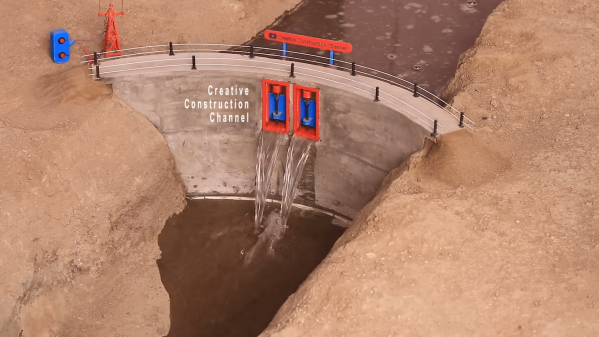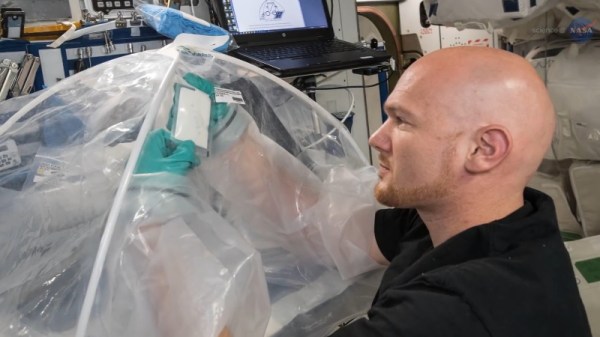It’s a story we’ve heard so many times over the years: breathless reporting of a new scientific breakthrough that will deliver limitless power, energy storage, or whichever other of humanity’s problems needs solving today. Sadly, they so often fail to make the jump into our daily lives because the reporting glosses over some exotic material that costs a fortune or because there’s a huge issue elsewhere in their makeup. There’s a story from MIT that might just be the real thing, though, as a team from that university claim to have made a viable supercapacitor from materials as simple as cement, carbon black, and a salt solution. Continue reading “MIT Cracks The Concrete Capacitor”
cement16 Articles
Miniature Concrete Hoover Dam Is Tiny Engineering Done Right
Growing up, we got to play with all kinds of things in miniature. Cars, horses, little LEGO houses, the lot. What we didn’t get is a serious education with miniature-sized dams. This recreation of the glorious Hoover Dam from the [Creative Construction Channel] could change all that for the next generation.
The build starts with the excavation of a two-foot long curve in a replica riverbed. A cardboard base is installed in the ditch, and used as a base for vertical steel wires. Next, the arch of the dam is roughed out with more steel wires installed horizontally to create a basic structure. The cardboard is then be removed from the riverbed, with the steel structure remaining. It’s finally time to pour real concrete, with a foundation followed by the main pour into foam formwork. The dam is also given 3D printed outlets that can be opened to allow water to pass through — complete with small gear motors to control them. The structure even gets a little roadway on top for good measure.
The finished product is quite impressive, and even more so when the outlets open up to spill water through. Such a project would be great fun for high school science students, or even engineering undergrads. Who doesn’t want to play with a miniature scale dam, after all? Bonus points if you build an entire LEGO city downstream, only to see it destroyed in a flood.
Continue reading “Miniature Concrete Hoover Dam Is Tiny Engineering Done Right”
Self-Healing Concrete: What Ancient Roman Concrete Can Teach Us
Concrete is an incredibly useful and versatile building material on which not only today’s societies, but also the ancient Roman Empire was built. To this day Roman concrete structures can be found in mundane locations such as harbors, but also the Pantheon in Rome, which to this day forms the largest unreinforced concrete dome in existence at 43.3 meters diameter, and is in excellent condition despite being being nearly 1,900 years old.
Even as the Roman Empire fell and receded into what became the Byzantine – also known as the Eastern Roman – Empire and the world around these last remnants of Roman architecture changed and changed again, all of these concrete structures remained despite knowledge of how to construct structures like them being lost to the ages. Perhaps the most astounding thing is that even today our concrete isn’t nearly as durable, despite modern inventions such as reinforcing with rebar.
Reverse-engineering ancient Roman concrete has for decades now been the source of intense study and debate, with a recent paper by Linda M. Seymour and colleagues adding an important clue to the puzzle. Could so-called ‘hot mixing’, with pockets of reactive lime clasts inside the cured concrete provide self-healing properties?
Continue reading “Self-Healing Concrete: What Ancient Roman Concrete Can Teach Us”
Concrete Boat Cements Its Way To High Speeds
Steel is scarce. Wood is not an option. And you need a boat now. These wartime circumstances drove innovation in all kinds of crazy directions, and one somewhat less crazy direction — concrete boats. As [Peter Sripol] demonstrates in the video below the break, making an RC concrete boat isn’t hard. Making a fast one on the other hand is. But that didn’t stop him from trying, and we think the effort deserves a look.
Starting with a basic displacement style hull, [Peter] and his cohorts experimented with a simple RC boat that worked, but could only move at slow speeds. They turned things up a notch or two and instead modeled their concrete boat after an RC speedboat hull that they had on hand.
The construction methods left a lot to be desired though, and they even tried various wire meshes as rebar, but they proved too heavy. Eventually though, they got a working hull, and had some fun with it. Rather than try to make the hull watertight with a rudder and propeller, they opted for a ducted fan and an airboat style rudder to make what they call the “world’s fastest concrete boat”.
Whether it’s the fastest or not is unconfirmed, but it is fast and actually gets on step fairly nicely. We applaud the exploration of alternative materials and the experimentation with different build methods. If building things with concrete floats your boat, then be sure to check out this concrete pinhole camera.
Continue reading “Concrete Boat Cements Its Way To High Speeds”
A Good, Hard Look At Pre-Stressed Concrete
From the looks of the average driveway or sidewalk, it may seem as though concrete is just destined to crack. But if concrete is so prone to cracking, how are we able to use it in so many high-stress applications like bridges and skyscrapers? This question came about while I was researching 3D-printed thermite for an article. Thermite is often used in welding railroad tracks, and I linked a video of fresh tracks being welded that had concrete ties. I knew I had to find out how concrete could be made to withstand the pressure of freight trains.
On its own, concrete is brittle and has no give to it at all. But that doesn’t mean it isn’t strong. Although concrete has good compression strength, the tensile strength is quite poor. Around the late 1800s, someone thought to fortify spans of concrete with steel reinforcing bars, better known as rebar. Steel can stretch, adding steel bars gives the concrete some tensile strength to go along with its compressive strength. Rebar also allows for thinner slabs and other members.
Rebar Only Goes So Far

Rebar or mesh-enforced concrete is good for things like parking lot blocks and roads, but it still fails before it ought to. In fact, it usually has to crack before the rebar can chip in any of its tensile strength.
In high-stress concrete applications like bridges and skyscrapers, it’s terrifically important to avoid deflection — that’s when a concrete member flexes and bends under load. Deflection can cause the modern glass skins to pop off of skyscrapers, among other problems.
A solid, rigid bridge is much nicer to walk, drive, and bicycle on than a bridge that sways in the breeze. But how do you do make a rigid bridge? One solution is to apply stresses to the concrete before it ever bears the load of cars and trucks or a steady schedule of freight trains.
Pre-stressed concrete is like rebar-enforced concrete, but with the added power of tension baked in. By adding stress to the concrete before it goes into service, deflection will be reduced or perhaps eliminated altogether. With the addition of tensile strength, more of the concrete’s own strength is able to come into play.
Continue reading “A Good, Hard Look At Pre-Stressed Concrete”
Hackaday Podcast 038: Cyberdecks Taking Over, Resin 3D-Printing Vs FDM, Silicone Injection Molding, And The Pickle Fork Fiasco
Hackaday Editors Tom Nardi and Mike Szczys comb through their favorite hacks from the past week. We loved Donald Papp’s article on considerations before making the leap from FDM 3D Printers to a resin-based process, and we solidify our thoughts on curing cement in low-gravity. Tom’s working on a Cyberdeck build, and he also found an ancient episode of an earlier and much different version of the Hackaday podcast. We’re impressed with a mostly 3D-printed useless machine, a thermal-insert press that’s also 3D-printed, and the Raspberry-Pi based Sidekick clone that popped up this week. A DIY wire-bending robot is an incredible build, as is the gorgeous wire-routing in a mechanical keyboard, and the filigree work on this playing card press. Plus you need to spend some time getting lost in this one hydrogen-line telescope project.
Take a look at the links below if you want to follow along, and as always tell us what you think about this episode in the comments!
Take a look at the links below if you want to follow along, and as always, tell us what you think about this episode in the comments!
Direct download (60 MB or so.)
Off-World Cement Tested For The First Time
If the current Administration of the United States has their way, humans will return to the surface of the Moon far sooner than many had expected. But even if NASA can’t meet the aggressive timeline they’ve been given by the White House, it seems inevitable that there will be fresh boot prints on the lunar surface within the coming decades. Between commercial operators and international competition, we’re seeing the dawn of a New Space Race, with the ultimate goal being the long-term habitation of our nearest celestial neighbor.

But even with modern technology, it won’t be easy, and it certainly won’t be cheap. While commercial companies such as SpaceX have significantly reduced the cost of delivering payloads to the Moon, we’ll still need every advantage to ensure the economical viability of a lunar outpost. One approach is in situ resource utilization, where instead of transporting everything from Earth, locally sourced materials are used wherever possible. This technique would not only be useful on the Moon, but many believe it will be absolutely necessary if we’re to have any chance of sending a human mission to Mars.
One of the most interesting applications of this concept is the creation of a building material from the lunar regolith. Roughly analogous to soil here on Earth, regolith is a powdery substance made up of grains of rock and micrometeoroid fragments, and contains silicon, calcium, and iron. Mixed with water, or in some proposals sulfur, it’s believed the resulting concrete-like material could be used in much the same way it is here on Earth. Building dwellings in-place with this “lunarcrete” would be faster, cheaper, and easier than building a comparable structure on Earth and transporting it to the lunar surface.
Now, thanks to recent research performed aboard the International Space Station, we have a much better idea of what to expect when those first batches of locally-sourced concrete are mixed up on the Moon or Mars. Of course, like most things related to spaceflight, the reality has proved to be a bit more complex than expected.
Continue reading “Off-World Cement Tested For The First Time”



















